Soviet HI-FI and its creators: Estonian children restructuring - laser players in the USSR
The Soviet sound cycle would not be complete without a story about almost mythical devices, Soviet CD players, as well as the discs that were made for them. At the beginning of the story, it should be recalled that the USSR was a unique country in which the total shortage of consumer goods could coexist with unique technical developments.
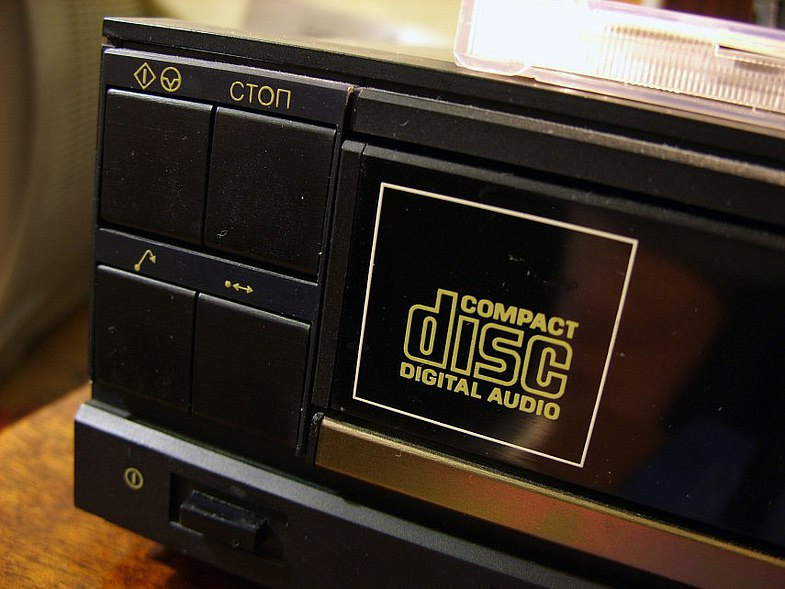
So, the first laser players in the Union appeared before the official CDs began to be published. At the same time, the population stood in queues for cassettes and vinyl plastics, which were bathed with great difficulty, as well as high-quality equipment for their reproduction. Not counting the vinyls with the speeches of Soviet leaders and the Soviet stage, who were present on the shelves of music stores in relative abundance.
')
At the same time, such a format as a CD in the world has existed since 1979, and the players and discs had time to be reborn from luxury goods into relatively affordable equipment for the middle class. In the USSR, on the contrary, throughout all these years, the broad masses simply did not know about the existence of such a format. The units of those who had the opportunity to buy a CD player outside the vast country, as a rule, did not use this chance. At times, tape recorders and LP players were bought more often. For the disks in the USSR were not even for sale at the “Fartsovshchikov”, and if they did appear, they were worth crazy money. The situation changed in 1987.
Ironically, the development of the first laser player in the USSR began in the city, which provided the country with audio cassettes. It was the Tallinn Music Cassettes Factory that collaborated with BASF and was the leader of the Soviet cassette production. But it is not about him now.
The initiative to create a Soviet CD player belonged to the institution “Management of the Organization of Trade, the Study of Demand and Advertising“ Orbit ”, unique for the late USSR. In 1985, clever people from this marketing department, whose names the history did not preserve in the sources accessible to me, insisted that the Ministry of Communications Industry should attend to the release of things that were so necessary for Soviet people.
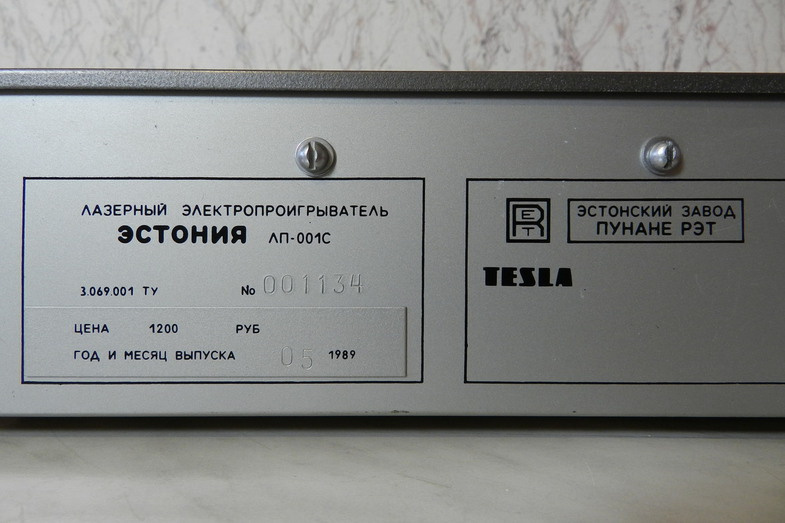
It is important that in the 80s the technological lag of Soviet enterprises from Western (especially in the consumer market) was so strong that the population had a reasonable question about the effectiveness of the Soviet economic system. Perestroika and glasnost, which fell on the heads of the Soviet people with the arrival of Gorbachev, increased the degree of public discontent.
At that time, it seemed to many that the appearance of new high-tech goods on the shelves and their availability in the trade network could significantly weaken the protest moods. Not the last role in this attempt to prove to the Soviet people that the collapsing Union "is still capable of catching up and overtaking ..." was assigned to sound-reproducing equipment.
As far as can be judged from the scattered memories of the staff of the Tallinn Punane RET plant, there were no problems with the organizational plan and the need to develop at that time. It was no longer the 70s, when Likhnitsky and Co. had to convince the stagnant-Brezhnev authorities that the country needed "Brigs" and "Corvettes". Interestingly, as in the case of the legendary amplifiers, the first CD player was developed at the enterprise, the main profile of which was orders for the military industrial complex. Direct project management was assigned to a 30-year-old engineer Vladimir Makarchuk.
As in the case of other high fidelity technology, they were based on already existing Western samples. They turned out to be popular in Germany and France, Philips CD players. On the basis of several Philips models (mainly Philips-100), the layout of the player was created. A characteristic feature of these samples was a lid that opened upwards, like many tape recorders of that time. At the same time borrowed a design concept from the Japanese company SHARP. This kind of plagiarism was characteristic of all audio equipment produced under the trademark “Estonia”.
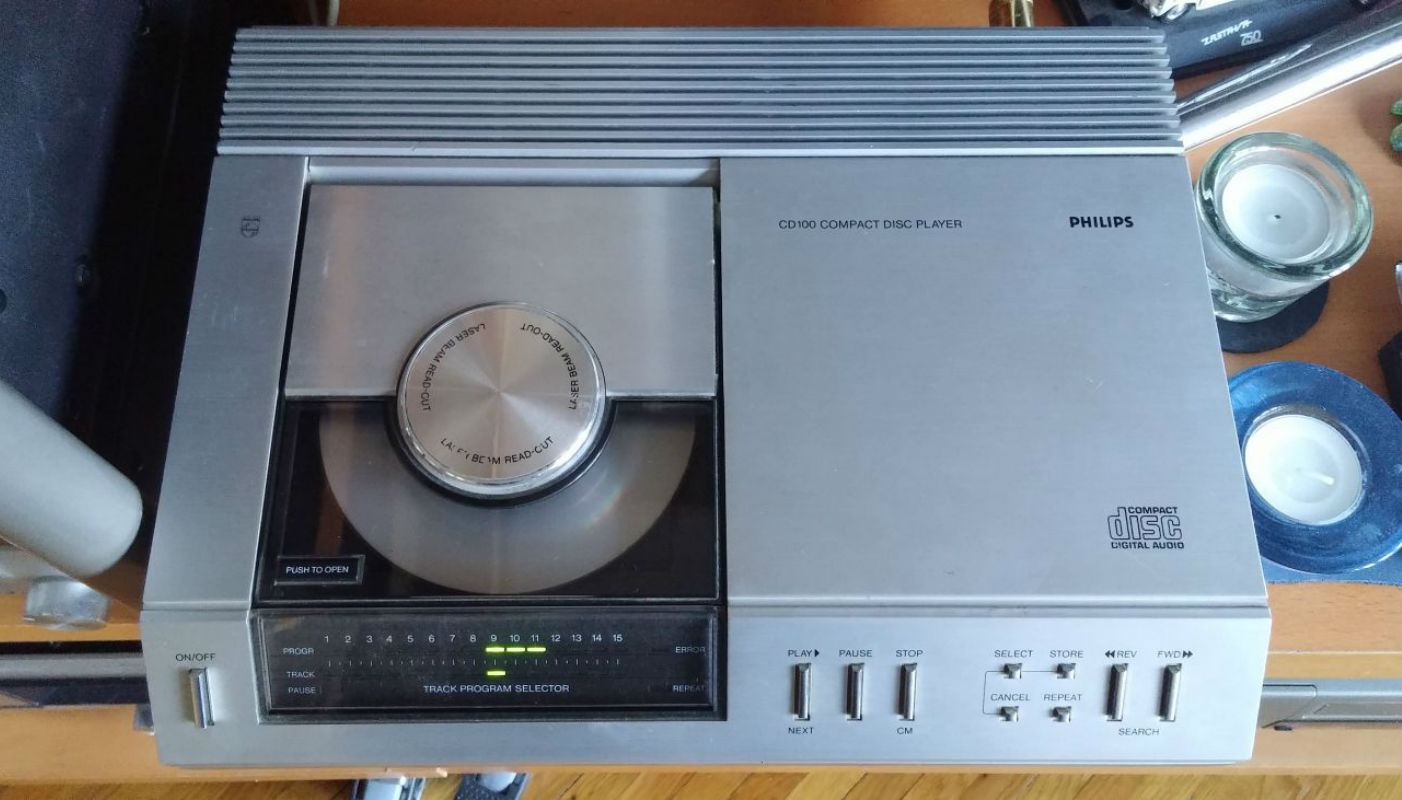
Philips-100
It cannot be said that the prototypes were copied completely, but many technical solutions were borrowed, since there was simply no experience in creating such equipment. By the end of 1986, it became clear that in a short time it was impossible and irrational to create our own CD and DAC drive. Such independent development and even copying of existing ones suggested the allocation of an incredible amount of resources, both human and material, and temporary. At the same time, the order of the “party and government” (tm) for the Soviet laser player was to be implemented at the mechanical engineering exhibition dedicated to the 70th anniversary of the Great October Revolution.
As a result of research conducted by Tallinn specialists, the Philips CDM-2 was chosen as the base drive for the Soviet device, the Philips 2X TDA 1540P became the DAC. Circuit design is largely repeated Western counterparts, however, has been adapted for the use of Soviet components.
The employees of the design office of the Punane RET plant, which developed the player, were among the first to introduce microprocessor control in a CD player. Two 8-bit Intel microprocessors were used. Many also argue that the reliability of the power system of the Soviet player has repeatedly exceeded the original from Philips .
This is how Estonia LP LP-010 Stereo appeared, which is deservedly considered the first CD player created in the USSR. Regarding the number of these devices there are completely different data. Some sources indicate that they were mass-produced for 2 years and there were more than 2500, in others they write that there were only a few units (50 pieces), and also that there was only small-scale production and the number did not exceed 200 pieces per union
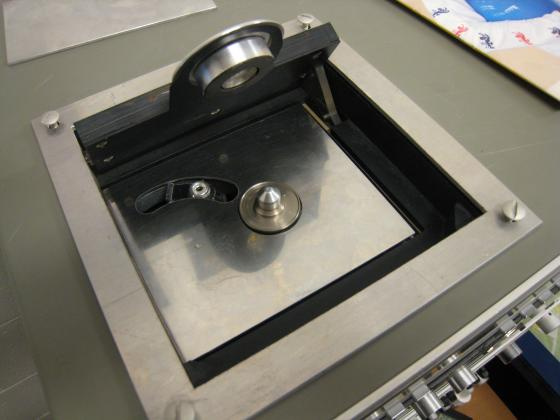
One way or another, there is fairly reliable evidence that at least one player “Estonia LP-010” hit the retail network and was sold in GUM for 1,100 Soviet rubles. The story from the exhibition, which was demonstrated by the Soviet miracle of technology fell into the program "Time".
However, the majority of Soviet people did not feel any better. No compact discs were produced in the USSR (since 1990, they were produced in small batches, mainly for export), and the cost of the device was equivalent to the cost of a new car.
Already in 1988, the USSR accepted 2 new GOSTs, which describe compact discs, - GOST 27667-88 “Digital sound system“ Compact disc ”. Parameters ”and GOST 28376-89“ Compact disc. Parameters and dimensions.
There are also reports that the device was released earlier, in 1984 - 1985, and in 1987 it just got on the exhibition and was demonstrated to the general public. And also, that engineer Makarchuk, just an employee of the Punane RET plant, who went to the exhibition, and other people were involved in the development (they were still young in 1984). There is no confirmation of either the first or the second version, only the fact remains that in the mid-80s the first Soviet CD player was developed.
The second (and, according to many, the first) serial player in the USSR, became Estonia LP-001, launched into the series in 1989. Schematically and constructively it was almost an exact copy of the Philips CD204. Unlike the previous development, almost the entire element base was borrowed. In addition to the case, foil-clad fiberglass for boards, plastic parts, a vacuum-luminescent display, resistors, wires, and fasteners, all parts of the device were imported. Of the characteristic features that significantly distinguish it from the first, you can select a sliding tray for the disk, instead of the cover.

Philips CD204

Estonia LP-001
The “circulation” of the device in most of the sources that can be considered reliable did not exceed 2500. It was a little easier to get this device than the one described above, but it was almost impossible to buy in the store. At that time, in order to get something, there were special people. The commission of these "useful" people accounted for about 100% of the value of the goods in short supply.
Before the collapse of the union, several more Soviet CD-decks were released, which, unfortunately, could not significantly change the situation, due to both the acute shortage of carriers and small series of releases.

Domestic release of compact discs began only in 1990. It is known that the most zealous supporter of their own CD release in the Union was Vadim Vasilievich Smirnov, leading specialist of the WFG “Melody” Department. He was known as an expert in digital media and urged the leadership of an all-Union record company to purchase equipment, and not to produce it over the hill.
This person determined the necessary equipment and prepared the ground for its purchase.
The release of the first CDs in the USSR was preceded by a 2-year internship of Melody employees at Western enterprises, where they studied in detail the technology of recording and producing disks. The trained specialists did not let us down, and in 1989 the first Soviet CD appeared with the record "Stichera for the Millennium of the Baptism of Rus", by composer Rodion Shchedrin.
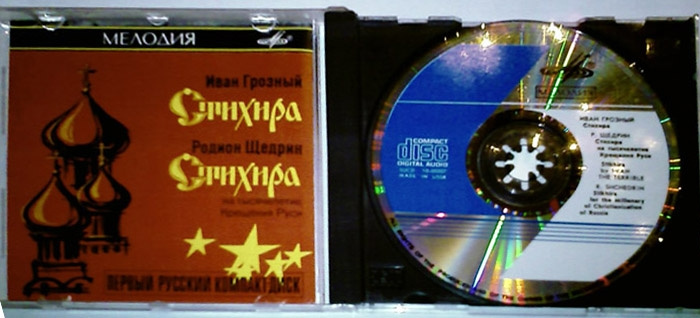
We all know that the efforts of engineers and industry officials from dust and dust in August 1991. The serial production of newborn Soviet laser players and CDs was not destined to last more than 4 years. The socioeconomic madness of the 90s and rampant privatization destroyed the industry, the shattered colossus. The company where the release of the first Soviet CD players began, turned out to be in another country. But that's another story ...

So, the first laser players in the Union appeared before the official CDs began to be published. At the same time, the population stood in queues for cassettes and vinyl plastics, which were bathed with great difficulty, as well as high-quality equipment for their reproduction. Not counting the vinyls with the speeches of Soviet leaders and the Soviet stage, who were present on the shelves of music stores in relative abundance.
')
At the same time, such a format as a CD in the world has existed since 1979, and the players and discs had time to be reborn from luxury goods into relatively affordable equipment for the middle class. In the USSR, on the contrary, throughout all these years, the broad masses simply did not know about the existence of such a format. The units of those who had the opportunity to buy a CD player outside the vast country, as a rule, did not use this chance. At times, tape recorders and LP players were bought more often. For the disks in the USSR were not even for sale at the “Fartsovshchikov”, and if they did appear, they were worth crazy money. The situation changed in 1987.
Laser beam in the dark kingdom of the Gorbachev era
Ironically, the development of the first laser player in the USSR began in the city, which provided the country with audio cassettes. It was the Tallinn Music Cassettes Factory that collaborated with BASF and was the leader of the Soviet cassette production. But it is not about him now.
The initiative to create a Soviet CD player belonged to the institution “Management of the Organization of Trade, the Study of Demand and Advertising“ Orbit ”, unique for the late USSR. In 1985, clever people from this marketing department, whose names the history did not preserve in the sources accessible to me, insisted that the Ministry of Communications Industry should attend to the release of things that were so necessary for Soviet people.

It is important that in the 80s the technological lag of Soviet enterprises from Western (especially in the consumer market) was so strong that the population had a reasonable question about the effectiveness of the Soviet economic system. Perestroika and glasnost, which fell on the heads of the Soviet people with the arrival of Gorbachev, increased the degree of public discontent.
At that time, it seemed to many that the appearance of new high-tech goods on the shelves and their availability in the trade network could significantly weaken the protest moods. Not the last role in this attempt to prove to the Soviet people that the collapsing Union "is still capable of catching up and overtaking ..." was assigned to sound-reproducing equipment.
Without sticks in the wheels is always easier
As far as can be judged from the scattered memories of the staff of the Tallinn Punane RET plant, there were no problems with the organizational plan and the need to develop at that time. It was no longer the 70s, when Likhnitsky and Co. had to convince the stagnant-Brezhnev authorities that the country needed "Brigs" and "Corvettes". Interestingly, as in the case of the legendary amplifiers, the first CD player was developed at the enterprise, the main profile of which was orders for the military industrial complex. Direct project management was assigned to a 30-year-old engineer Vladimir Makarchuk.
Hybrid Philips and Sharp, as well as the first Intel chips in the Soviet technology
As in the case of other high fidelity technology, they were based on already existing Western samples. They turned out to be popular in Germany and France, Philips CD players. On the basis of several Philips models (mainly Philips-100), the layout of the player was created. A characteristic feature of these samples was a lid that opened upwards, like many tape recorders of that time. At the same time borrowed a design concept from the Japanese company SHARP. This kind of plagiarism was characteristic of all audio equipment produced under the trademark “Estonia”.

Philips-100
It cannot be said that the prototypes were copied completely, but many technical solutions were borrowed, since there was simply no experience in creating such equipment. By the end of 1986, it became clear that in a short time it was impossible and irrational to create our own CD and DAC drive. Such independent development and even copying of existing ones suggested the allocation of an incredible amount of resources, both human and material, and temporary. At the same time, the order of the “party and government” (tm) for the Soviet laser player was to be implemented at the mechanical engineering exhibition dedicated to the 70th anniversary of the Great October Revolution.
As a result of research conducted by Tallinn specialists, the Philips CDM-2 was chosen as the base drive for the Soviet device, the Philips 2X TDA 1540P became the DAC. Circuit design is largely repeated Western counterparts, however, has been adapted for the use of Soviet components.
The employees of the design office of the Punane RET plant, which developed the player, were among the first to introduce microprocessor control in a CD player. Two 8-bit Intel microprocessors were used. Many also argue that the reliability of the power system of the Soviet player has repeatedly exceeded the original from Philips .
Estonia LP-010 Stereo
This is how Estonia LP LP-010 Stereo appeared, which is deservedly considered the first CD player created in the USSR. Regarding the number of these devices there are completely different data. Some sources indicate that they were mass-produced for 2 years and there were more than 2500, in others they write that there were only a few units (50 pieces), and also that there was only small-scale production and the number did not exceed 200 pieces per union

One way or another, there is fairly reliable evidence that at least one player “Estonia LP-010” hit the retail network and was sold in GUM for 1,100 Soviet rubles. The story from the exhibition, which was demonstrated by the Soviet miracle of technology fell into the program "Time".
However, the majority of Soviet people did not feel any better. No compact discs were produced in the USSR (since 1990, they were produced in small batches, mainly for export), and the cost of the device was equivalent to the cost of a new car.
Already in 1988, the USSR accepted 2 new GOSTs, which describe compact discs, - GOST 27667-88 “Digital sound system“ Compact disc ”. Parameters ”and GOST 28376-89“ Compact disc. Parameters and dimensions.
There are also reports that the device was released earlier, in 1984 - 1985, and in 1987 it just got on the exhibition and was demonstrated to the general public. And also, that engineer Makarchuk, just an employee of the Punane RET plant, who went to the exhibition, and other people were involved in the development (they were still young in 1984). There is no confirmation of either the first or the second version, only the fact remains that in the mid-80s the first Soviet CD player was developed.
Phillips and Estonia are twin brothers
The second (and, according to many, the first) serial player in the USSR, became Estonia LP-001, launched into the series in 1989. Schematically and constructively it was almost an exact copy of the Philips CD204. Unlike the previous development, almost the entire element base was borrowed. In addition to the case, foil-clad fiberglass for boards, plastic parts, a vacuum-luminescent display, resistors, wires, and fasteners, all parts of the device were imported. Of the characteristic features that significantly distinguish it from the first, you can select a sliding tray for the disk, instead of the cover.

Philips CD204

Estonia LP-001
The “circulation” of the device in most of the sources that can be considered reliable did not exceed 2500. It was a little easier to get this device than the one described above, but it was almost impossible to buy in the store. At that time, in order to get something, there were special people. The commission of these "useful" people accounted for about 100% of the value of the goods in short supply.
Before the collapse of the union, several more Soviet CD-decks were released, which, unfortunately, could not significantly change the situation, due to both the acute shortage of carriers and small series of releases.

Soviet CD
Domestic release of compact discs began only in 1990. It is known that the most zealous supporter of their own CD release in the Union was Vadim Vasilievich Smirnov, leading specialist of the WFG “Melody” Department. He was known as an expert in digital media and urged the leadership of an all-Union record company to purchase equipment, and not to produce it over the hill.
This person determined the necessary equipment and prepared the ground for its purchase.
The release of the first CDs in the USSR was preceded by a 2-year internship of Melody employees at Western enterprises, where they studied in detail the technology of recording and producing disks. The trained specialists did not let us down, and in 1989 the first Soviet CD appeared with the record "Stichera for the Millennium of the Baptism of Rus", by composer Rodion Shchedrin.

Total
We all know that the efforts of engineers and industry officials from dust and dust in August 1991. The serial production of newborn Soviet laser players and CDs was not destined to last more than 4 years. The socioeconomic madness of the 90s and rampant privatization destroyed the industry, the shattered colossus. The company where the release of the first Soviet CD players began, turned out to be in another country. But that's another story ...
Source: https://habr.com/ru/post/373767/
All Articles